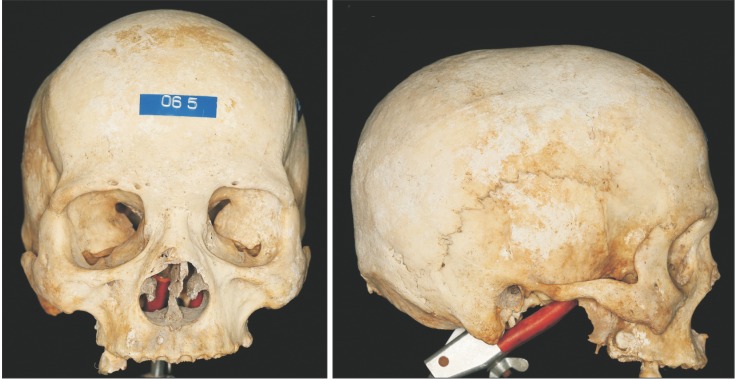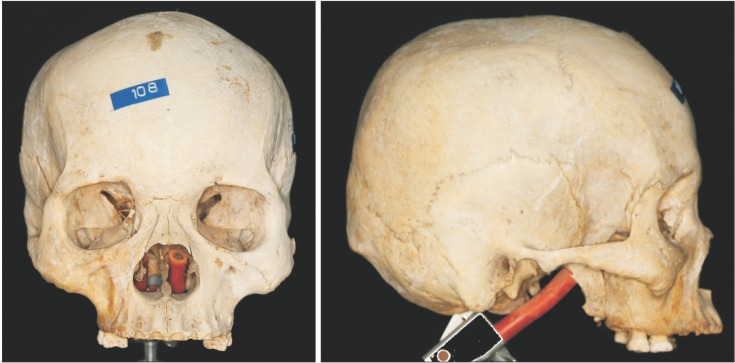Anat Cell Biol.
2018 Mar;51(1):25-30. 10.5115/acb.2018.51.1.25.
Cranial index in a modern people of Thai ancestry
- Affiliations
-
- 1Department of History, College of Liberal Art, Sejong University, Seoul, Korea. redqin@sejong.ac.kr
- 2Department of Anthropology, The State University of New York, Buffalo, NY, USA.
- 3The Chula Soft Cadaver Surgical Training Center and Department of Anatomy, Faculty of Medicine, Chulalongkorn University, Bangkok, Thailand. tansatit@yahoo.com
- KMID: 2418392
- DOI: http://doi.org/10.5115/acb.2018.51.1.25
Abstract
- The present research aims to examine the cranial index in a modern people of Thai ancestry. Ultimately, this study will help to create a databank containing a cranial index for the classifications of the people from Asia. In this study, 185 modern crania of people of supposed Thai ancestry were examined. They were collected from the Department of Anatomy at Chulalongkorn University in Bangkok, Thailand. The maximum cranial length and breadth were measured using standard anthropometric instruments based on Martin's methods. The cranial index was calculated using the equation ([maximum cranial breadth/maximum cranial length]×100). The mean cranial indices for the male and female skulls examined were 81.81±4.23 and 82.99±4.37, respectively. The most common type of skull in the modern Thai people in this study was the brachycranic type with a frequency of 42.7%, followed by the mesocranic (27.03%) and hyperbrachycranic types (25.59%). The rarest type observed in this study was the dolichocranic type (4.32%). The present study provides valuable data pertaining to the cranial index in a modern Thai population and reveals that modern Thai males and females belong to the brachycranic group. The results of this study will be of forensic anthropological importance to populations in close proximity to the location where the skulls studied here were sourced.
Keyword
MeSH Terms
Figure
Reference
-
1. von Cramon-Taubadel N. Evolutionary insights into global patterns of human cranial diversity: population history, climatic and dietary effects. J Anthropol Sci. 2014; 92:43–77. PMID: 24038629.2. Liebenberg L, Stull KE, L'Abbe EN, Botha D. Evaluating the accuracy of cranial indices in ancestry estimation among South African groups. J Forensic Sci. 2015; 60:1277–1282. PMID: 25772025.3. Kanchan T, Krishan K, Gupta A, Acharya J. A study of cranial variations based on craniometric indices in a South Indian population. J Craniofac Surg. 2014; 25:1645–1649. PMID: 25162547.4. Stolovitzky JP, Todd NW. Head shape and abnormal appearance of tympanic membranes. Otolaryngol Head Neck Surg. 1990; 102:322–325. PMID: 2113257.5. Cohen MM Jr, Kreiborg S. Cranial size and configuration in the Apert syndrome. J Craniofac Genet Dev Biol. 1994; 14:153–162. PMID: 7852544.6. Adejuwon SA, Salawu OT, Eke CC, Femi-Akinlosotu W, Odaibo AB. A craniometric study of adult humans skulls from South-western Nigeria. Asian J Med Sci. 2011; 3:23–25.7. Ilayperuma I. Evaluation of cephalic indices: a clue for racial and sex diversity. Int J Morphol. 2011; 29:112–117.8. Ishida H. Metric and nonmetric cranial variation of the prehistoric Okhotsk people. Anthropol Sci. 1996; 104:233–258.9. Koh KS, Han SH, Song WC, Sohn HJ, Paik DJ, Kim HJ, Choi BY. Secular changes of cephalic index in Korean adults. Korean J Phys Anthropol. 2001; 14:177–185.10. Pietrusewsky M. A multivariate analysis of measurements recorded in early and more modern crania from East Asia and Southeast Asia. Quat Int. 2010; 211:42–54.11. Buikstra JE, Ubelaker DH. Standards for data collection from human skeletal remains. Arkansas Archaeological Survey Research Series 44. Fayetteville: Arkansas Archaeological Survey;1994.12. Ubelaker DH. Human skeletal remains: excavation, analysis, interpretation. Washington, DC: Taraxacum;1999.13. White TD, Folkens PA. The human bone manual. Amsterdam: Academic Press;2005.14. Martin R, Knussmann R. Anthropologie. Handbuch der vergleichenden. Biologie des Menschen. Band I. Stuttgart: Fischer Verlag;1988.15. Sangvichien S, Boonkaew K, Chuncharunee A, Komoltri C, Piyawinijwong S, Wongsawut A, Namwongsa S. Sex determination in Thai skulls by using craniometry: multiple logistic regression analysis. Siriraj Med J. 2007; 59:216–221.16. Rooppakhun S, Surasith P, Vatanapatimakul N, Kaewprom Y, Sitthiseripratip K. Craniometric study of Thai skull based on three-dimensional computed tomography (CT) data. J Med Assoc Thai. 2010; 93:90–98. PMID: 20196417.17. Han SH, Hwang YI, Lee KH, Koh KS, Choi BY, Lee KS, Lee HY, Sir WS, Chung MS, Kim HJ, Kim DW, Kang HS. Craniometric study in modern Korean adults. Korean J Phys Anthropol. 1995; 8:205–213.18. Freas LE. Patterns of craniometric variation in modern Thai populations: applications in forensic antropology and implications for population history [dissertation]. Gainesville, FL: University of Florida;2011.19. Kimmerle EH, Ross A, Slice D. Sexual dimorphism in America: geometric morphometric analysis of the craniofacial region. J Forensic Sci. 2008; 53:54–57. PMID: 18279240.20. Green H, Curnoe D. Sexual dimorphism in southeast Asian crania: a geometric morphometric approach. Homo. 2009; 60:517–534. PMID: 19853250.21. King CA. Osteometric assessment of 20th century skeletons from Thailand and Hong Kong [dissertation]. Boca Raton, FL: Florida Atlantic University;1997.22. Howells WW. Metrical analysis in the problem of Australian origins. In : Kirk RL, Thorne AG, editors. The Origin of the Australians. Canberra: Australian Institute of Aboriginal Studies;1976. p. 141–160.23. Desai SD, Shaik HS, Shepur MP, Thomas ST, Mavishettar GF, Haseena S. A craniometric study of South Indian adult dry skulls. J Pharm Sci Res. 2013; 5:33–34.24. Boonlop K, Bubpha S. A physical anthropology perspective on a mainland Southest Asian agrarian population: prehistoric skulls of Ban Chiang. In : Enfield NJ, editor. Dynamics of Human Diversity. Canberra: Pacific Linguistics;2011. p. 179–203.25. Kouchi M. Brachycephalization in Japan has ceased. Am J Phys Anthropol. 2000; 112:339–347. PMID: 10861351.26. Kasai K, Richards LC, Brown T. Comparative study of craniofacial morphology in Japanese and Australian aboriginal populations. Hum Biol. 1993; 65:821–834. PMID: 8262507.27. Hossain MG, Saw A, Ohtsuki F, Lestrel PE, Kamarul T. Change in facial shape in two cohorts of Japanese adult female students twenty years apart. Singapore Med J. 2011; 52:818–823. PMID: 22173252.28. Li YY, Brace CL, Gao QA, Tracer DP. Dimensions of face in Asia in the perspective of geography and prehistory. Am J Phys Anthropol. 1991; 85:269–279. PMID: 1897599.29. Pietrusewsky M, Chang C. Taiwan aboriginals and peoples of the Pacific-Asia region: multivariate craniometric comparisons. Anthropol Sci. 2003; 111:293–332.30. Hanihara T. Population prehistory of east Asia and the Pacific as viewed from craniofacial morphology: the basic populations in east Asia, VII. Am J Phys Anthropol. 1993; 91:173–187. PMID: 8317559.31. Jantz RL. Cranial change in Americans: 1850-1975. J Forensic Sci. 2001; 46:784–787. PMID: 11451056.32. Green R, Chapman PM. The problem with indices. Mar Pollut Bull. 2011; 62:1377–1380. PMID: 21376349.33. Kanchan T, Gupta A, Krishan K. Catergorization of human crania using cranial indices in a South Indian population. In : Proceedings of the 66th Annual Meeting of the Academy of Forensic Sciences; 2014 Feb 17-22; Seattle, WA, USA. Colorado Springs, CO: American Academy of Forensic Sciences;2014.
- Full Text Links
- Actions
-
Cited
- CITED
-
- Close
- Share
- Similar articles
-
- A Study on the Korean Orbital and Cranial Index Using 3D Skull CT Image and Morphometric Analysis
- Validation of the Thai Version of the Movement Disorder Society-Sponsored Revision of the Unified Parkinson's Disease Rating Scale
- Craniometric study for sex determination in a Thai population
- Dream and Prophecy
- A new method for sex estimation from maxillary suture length in a Thai population



